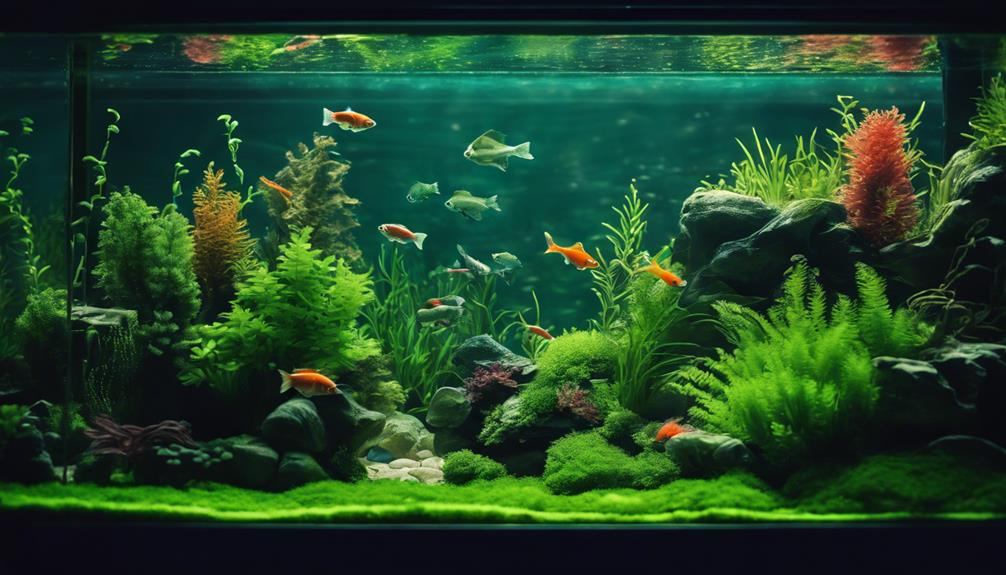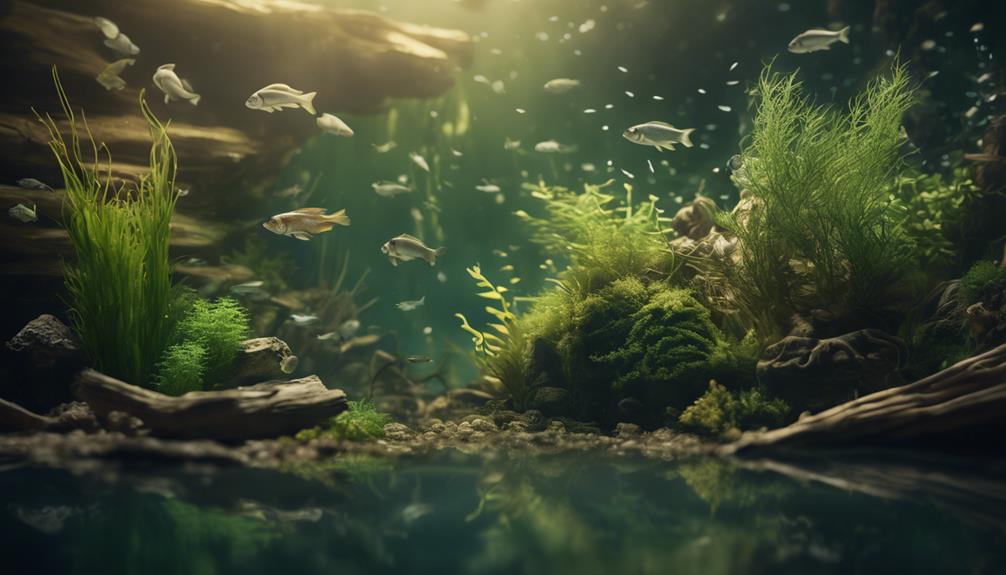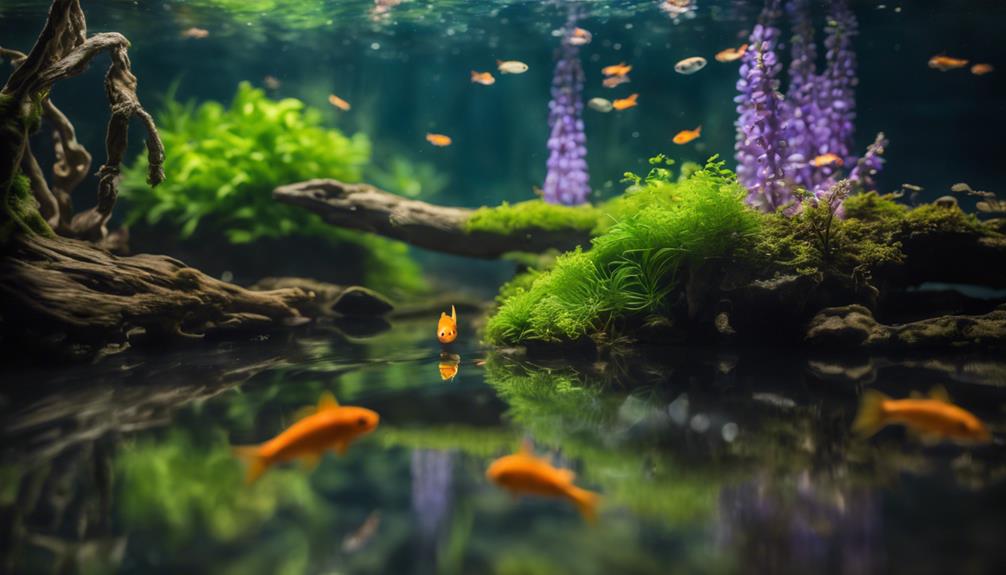When creating a thriving aquatic ecosystem, you'll want to select aquatic plants that not only provide aesthetic appeal but also cater to the specific needs of your fish, including shelter, food, and ideal water quality. Ideal plants, such as Java moss and Anacharis, provide hiding places, breeding grounds, and food sources, allowing fish to thrive. They also help maintain a stable ecosystem by regulating water temperature, pH, and oxygen levels. Consider plants that match your aquarium's environment and fish species, and be prepared to provide the right balance of light, nutrients, and CO2 supplementation to support their growth. As you explore further, you'll discover the perfect blend of plants to create a harmonious habitat for your fish.
Table of Contents
Key Takeaways
- Select plants that provide shelter, food, and water quality improvement, such as Java Moss, Anacharis, and Vallisneria, for a balanced ecosystem.
- Choose plants with different growth rates, textures, and colors to create a diverse and thriving habitat for fish.
- Consider the specific needs of fish species, such as breeding habits, when selecting aquatic plants for the tank.
- Ensure plants receive adequate light, nutrients, and water circulation to promote healthy growth and maintain water quality.
- Incorporate plants that help maintain water quality, such as Water Wisteria, to create a stable and thriving environment for fish.
Environmental Requirements for Plants
When selecting aquatic plants for fish habitat, you must consider the specific environmental requirements of the plants, as they've adapted to thrive in certain conditions that may vary greatly from one species to another.
For instance, some plants require high levels of light, while others can tolerate low-light conditions. You'll need to guarantee that your chosen plants can thrive in the water temperature and pH levels of your aquarium.
Some plants, like Java moss, prefer cooler temperatures, whereas others, like Anacharis, thrive in warmer waters.
Additionally, you should consider the water movement and flow in your aquarium, as some plants require strong currents to stay healthy.
You'll also need to think about the substrate and decorations in your tank, as some plants need specific types of soil or surfaces to anchor themselves.
By understanding the environmental requirements of your chosen plants, you can create a thriving ecosystem that supports both your fish and plants.
Plant Nutrition and CO2 Supplementation
To guarantee the ideal growth and health of your aquatic plants, you'll need to provide them with a balanced diet of essential nutrients and consider supplementing with CO2, a vital component of photosynthesis.
A well-rounded fertilizer should include nitrogen, phosphorus, potassium, iron, magnesium, manganese, and other minerals. You can use liquid fertilizers or substrates specifically designed for aquatic plants. Aqueon Aquarium Plant Food is a great option, providing a balanced blend of nutrients for most plant species.
CO2 supplementation can enhance plant growth, color, and health, but it's not necessary for success. The type and amount of CO2 supplementation will depend on the specific plant species, water parameters, and lighting conditions.
Pressurized CO2 injection systems are the most reliable and convenient method, but other methods like liquid supplements, tablets, or DIY yeast generators can also be effective.
Laterite, an iron-rich clay, can be mixed into the substrate to provide essential micronutrients to root-feeding plants, promoting healthy growth and development.
Benefits and Types of Aquatic Plants

By incorporating aquatic plants into your aquarium, you can experience a range of benefits, from improved water quality and aesthetics to enhanced biodiversity and habitat creation for your fish.
Aquatic plants are natural water purifiers, absorbing excess nutrients, heavy metals, and toxins, creating a healthier environment for your fish. They also provide hiding places, breeding grounds, and food sources, allowing your fish to thrive.
In addition, aquatic plants help maintain a stable ecosystem by regulating water temperature, pH, and oxygen levels.
There are several types of aquatic plants to choose from, each with its unique characteristics and requirements.
You can opt for floating plants like water wisteria or water lettuce, which provide shade and shelter for your fish.
Submerged plants like anacharis or cabomba are great for creating hiding places and providing food.
Emergent plants like cattails or water lilies thrive in shallow water and create a natural barrier between the aquarium and its surroundings.
Selecting Ideal Plants for Fish Habitat
When selecting ideal plants for your fish habitat, you'll want to weigh the specific needs of your aquatic ecosystem.
You'll need to choose plants that provide the right balance of shelter, food, and water quality improvement for your fish and fry.
Plant Selection Criteria
You must consider several key factors when selecting aquatic plants to create an ideal habitat for fish.
The plant selection criteria you use will directly impact the health and well-being of your aquatic friends.
Initially, consider the water conditions in which your fish will thrive. Different plants have specific requirements for pH, temperature, and light levels, so you must verify that you choose plants that match your aquarium's environment.
Next, think about the growth habits and sizes of the plants you're considering. You'll want to guarantee they provide adequate shelter and hiding places for your fish without overcrowding the tank.
Additionally, consider the plants' ability to provide food and nutrients for your fish. Some plants, like duckweed, can serve as a natural food source, while others, like anacharis, can help maintain water quality.
Plant Types for Habitat
Selecting ideal plants for your fish habitat involves choosing species that cater to the specific needs of your aquatic friends, and several types of aquatic plants stand out for their ability to provide shelter, food, and perfect water conditions.
When it comes to creating a thriving fish habitat, you'll want to ponder plants that provide hiding places, spawning grounds, and a natural food source for your fish.
Java Moss and Hornwort are perfect for creating a natural spawning ground and hiding places for breeding fish and fry.
Vallisneria and Water Wisteria provide hiding places, absorb excess nutrients, and can be used as background plants or trained to grow on a trellis.
Dwarf Hairgrass is a low-maintenance option that provides a natural spawning ground, a source of food for fry, and helps to absorb excess nutrients.
Popular Aquatic Plants for Breeding

Among the most sought-after aquatic plants for breeding, Java moss and Anacharis have proven particularly effective at fostering a conducive environment for fish reproduction.
As you set up your aquarium, you'll want to ponder these plants for their ability to provide shelter, food, and a sense of security for your fish.
Java moss, with its delicate, carpet-like texture, creates an ideal substrate for eggs to settle and develop.
Anacharis, on the other hand, serves as a nutritious food source for breeding fish, rich in essential nutrients and vitamins.
Both plants are easy to care for and can thrive in a well-maintained aquarium.
By incorporating these aquarium plants into your breeding setup, you'll be creating an environment that encourages healthy reproduction and supports the well-being of your fish.
With the right combination of plants, you'll be well on your way to fostering a thriving community of fish that breed and flourish in their habitat.
Creating a Natural Environment for Fish
By incorporating a diverse range of aquatic plants, you can create a natural environment that closely mimics the fish's native habitat, providing them with the comfort and security they need to thrive.
This is especially important for breeding fish and fry, which require specific conditions to survive and grow.
Some aquatic plants are particularly well-suited for creating a natural environment.
Java Moss provides cover for breeding fish and fry, and can be attached to rocks or driftwood to create a natural habitat.
Vallisneria is a tall and hardy plant that provides hiding places for breeding fish and fry, and can be used as a background plant.
Hornwort is a fast-growing plant that provides hiding places for breeding fish and fry, and can be used as a mid-water or background plant.
Plant Care and Maintenance Tips

You'll need to establish a regular routine for pruning, fertilizing, and monitoring water parameters to guarantee your aquatic plants thrive and provide a healthy habitat for your fish.
Regular pruning is vital to maintain the shape and size of your plants, promote healthy growth, and encourage the production of new shoots and roots.
Verify your plants receive adequate light, with most species requiring 10-12 hours of light per day and a Kelvin rating between 6,500K and 8,000K for peak growth and color.
In your planted aquarium, consider supplementing with carbon dioxide (CO2) to enhance plant growth, but it's not necessary for success.
Pressurized injection systems are the most reliable and convenient method of supplying CO2.
Fertilize your plants regularly with a balanced fertilizer that provides essential nutrients like nitrogen, phosphorus, and potassium.
Iron-rich clay can be mixed into the substrate for root-feeding plants.
Finally, regularly monitor water parameters, aiming for a pH between 6.5 and 7.8, general hardness between 50 ppm and 100 ppm, and alkalinity between 3° and 8° dKH.
Designing a Thriving Aquatic Ecosystem
When creating a thriving aquatic ecosystem, selecting the right aquatic plants is crucial, as they provide essential benefits to fish, including hiding places, food, and breeding grounds.
You'll want to choose plants that cater to the specific needs of your fish, such as Java Moss, Hornwort, and Anacharis, which offer a source of food and shelter.
To create a balanced and visually appealing ecosystem, consider incorporating a diverse range of aquatic plants with different growth rates, textures, and colors.
Some great options include:
Vallisneria, which provides a natural hiding place for fish.
Water Wisteria, which helps to maintain water quality.
Dwarf Hairgrass, which adds a touch of natural beauty to your aquarium.
Overcoming Common Plant Care Challenges

As you introduce aquatic plants to your aquarium, be prepared to tackle common care challenges that can hinder their growth and overall health.
One vital aspect of plant care is regular pruning and trimming, which prevents overgrowth and shading out of other plants in the tank. You'll also need to maintain a balanced fertilizer regimen, including macronutrients like nitrogen, phosphorus, and potassium, as well as micronutrients like iron and magnesium, to promote healthy plant growth.
Other challenges you may face include insufficient light, inadequate water circulation, and poor water quality, which can lead to algae growth and create an unhealthy environment for your fish.
Make sure to provide specific water parameters, such as pH, temperature, and hardness, that are compatible with the natural habitats of your aquatic plants. Failure to do so can lead to plant stress and death.
Additionally, be on the lookout for common pests like snails, algae, and plant-eating fish, and take regular monitoring and control measures to prevent infestations.
Frequently Asked Questions
What Plant Is Best for Fish Tank?
When selecting a plant for your fish tank, you'll want one that provides benefits for your aquatic friends. Consider Water Wisteria, a versatile, fast-growing plant that offers hiding places, oxygenation, and a food source for your fish, making it an excellent choice for a thriving tank.
How Do You Set up Aquatic Plants in a Fish Tank?
You're about to reveal the secret to a thriving aquatic oasis! To set up aquatic plants in your fish tank, start by considering the Lighting Requirements, choosing plants that match your tank's lighting conditions, and positioning them for peak growth.
Is It Good to Put Live Plants in a Fish Tank?
You're wondering if it's good to put live plants in a fish tank? Absolutely! Live plants provide numerous benefits, including improved water quality, reduced stress, and a natural environment, ultimately creating a thriving ecosystem for your fish to flourish.
What Is the Best Plant to Hide in a Fish Tank?
When choosing a plant for camouflage, you'll want one that provides effective cover without obstructing swimming space. Look for plants with dense foliage, like Java Moss or Water Wisteria, which offer excellent plant camouflage for your fish to hide and thrive.
Conclusion
Creating an ideal aquatic environment for fish relies heavily on selecting the right plants.
Did you know that aquatic plants can reduce algae growth by up to 90%?
By incorporating plants that thrive in your tank's conditions, you'll not only enhance your fish's habitat but also maintain a healthy ecosystem.
With the knowledge you've gained, you're now equipped to design a thriving aquatic world that your fish will love.

